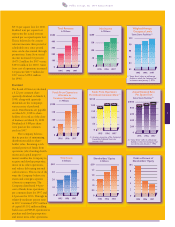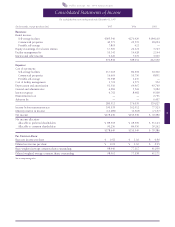Public Storage 1997 Annual Report Download - page 17
Download and view the complete annual report
Please find page 17 of the 1997 Public Storage annual report below. You can navigate through the pages in the report by either clicking on the pages listed below, or by using the keyword search tool below to find specific information within the annual report.
15
Public Storage, Inc. 1997 Annual Report
Financial instruments
For purposes of financial statement presentation, the Company considers all highly liquid debt instruments purchased with a maturity of
three months or less to be cash equivalents.
The carrying amount of cash and cash equivalents and mortgage notes receivable approximates fair value because with respect to cash and
cash equivalents maturities are less than three months and with respect to the mortgage notes receivable applicable interest rates approximate
market rates for these loans. The carrying amount of the Company’s fixed rate long-term debt is estimated using discounted cash flow analyses
based on incremental borrowing rates the Company believes it could obtain with similar terms and maturities.
Real estate facilities
Real estate facilities are recorded at cost. Depreciation is computed using the straight-line method over the estimated useful lives of the
buildings and improvements, which are generally between 5 and 25 years.
Allowance for possible losses
The Company has no allowance for possible losses relating to any of its real estate investments, long-lived assets and mortgage notes receivable.
The need for such an allowance is evaluated by management by means of periodic reviews of its investment portfolio.
Intangible assets
Intangible assets consist of property management contracts ($165,000,000) and the cost over the fair value of net tangible and identifiable
intangible assets ($67,726,000) acquired in the PSMI Merger. Intangible assets are amortized straight-line over 25 years. At December 31,
1997 and 1996, intangible assets are net of accumulated amortization of $19,782,000 and $10,473,000, respectively. Included in depreciation
and amortization expense is $9,309,000 in 1997, $9,309,000 in 1996 and $1,164,000 in 1995 (for the period from November 16, 1995
through December 31, 1995) related to the amortization of intangible assets.
Revenue and expense recognition
Property rents are recognized as earned. Equity in earnings of real estate entities are recognized based on the Company’s ownership interest
in the earnings of each of the unconsolidated real estate entities. Advertising costs are expensed as incurred.
Environmental costs
The Company’s policy is to accrue environmental assessments and/or remediation cost when it is probable that such efforts will be required and
the related costs can be reasonably estimated. The majority of the Company’s real estate facilities were acquired prior to the time that it was
customary to conduct environmental assessments. During 1995, the Company and the Consolidated Entities conducted independent environmental
investigations of their real estate facilities. As a result of these investigations, the Company recorded an amount which, in management’s best
estimate and based upon independent analysis, was sufficient to satisfy anticipated costs of known remediation requirements. At December 31,
1995, the Company accrued $2,741,000 for estimated environmental remediation costs. Similar to the Company, real estate entities in which the
Company accounts for using the equity method recorded environmental accruals at the end of 1995. The Company’s pro rata share, based on its
ownership interest, totaled $510,000 and is included in “Equity in earnings of real estate entities” in 1995. Although there can be no assurance,
the Company is not aware of any environmental contamination of any of its facilities which individually or in the aggregate would be material
to the Company’s overall business, financial condition, or results of operations.
Net income per common share
In 1997, the Financial Accounting Standards Board issued Statement No. 128, Earnings per Share. Statement 128 replaced the calculation
of primary and fully diluted net income per share with basic and diluted net income per share. Unlike primary net income per share, basic
net income per share excludes any dilutive effects of options, warrants and convertible securities. Diluted net income per share is very similar
to the previously reported fully diluted net income per share. All net income per share amounts for all periods have been presented and
where appropriate, restated to conform to Statement 128 requirements.
Diluted net income per common share is computed using the weighted average common shares outstanding (adjusted for stock options).
The Class B Common Stock is not included in the determination of net income per common share because all contingencies required for
the conversion to common stock have not been satisfied as of December 31, 1997. In addition, the inclusion of the Company’s convertible
preferred stock in the determination of net income per common share has been determined to be anti-dilutive.
In computing earnings per common share, preferred stock dividends totaling $88,393,000, $68,599,000 and $31,124,000 for the years
ended December 31, 1997, 1996 and 1995, respectively, reduced income available to common stockholders.
























